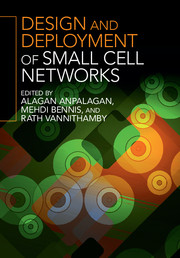Book contents
- Frontmatter
- Contents
- List of contributors
- Preface
- 1 Mobility performance optimization for 3GPP LTE HetNets
- 2 Design and performance analysis of multi-radio small cell networks
- 3 Dynamic TDD small cell management
- 4 3GPP RAN standards for small cells
- 5 Dense networks of small cells
- 6 Traffic offloading scenarios for heterogeneous networks
- 7 Required number of small cell access points in heterogeneous wireless networks
- 8 Small cell deployments: system scenarios, performance, and analysis
- 9 Temporary cognitive small cell networks for rapid and emergency deployments
- 10 Long-term evolution (LTE) and LTE-Advanced activities in small cell networks
- 11 Game theory and learning techniques for self-organization in small cell networks
- 12 Energy efficient strategies with BS sleep mode in green small cell networks
- 13 Mobility management in small cell heterogeneous networks
- 14 The art of deploying small cells: field trial experiments, system design, performance prediction, and deployment feasibility
- 15 Centralized self-optimization of interference management in LTE-A HetNets
- 16 Self-organized ICIC for SCN
- 17 Large-scale deployment and scalability
- 18 Energy efficient heterogeneous networks
- 19 Time- and frequency-domain e-ICIC with single- and multi-flow carrier aggregation in HetNets
- Index
- References
1 - Mobility performance optimization for 3GPP LTE HetNets
Published online by Cambridge University Press: 05 December 2015
- Frontmatter
- Contents
- List of contributors
- Preface
- 1 Mobility performance optimization for 3GPP LTE HetNets
- 2 Design and performance analysis of multi-radio small cell networks
- 3 Dynamic TDD small cell management
- 4 3GPP RAN standards for small cells
- 5 Dense networks of small cells
- 6 Traffic offloading scenarios for heterogeneous networks
- 7 Required number of small cell access points in heterogeneous wireless networks
- 8 Small cell deployments: system scenarios, performance, and analysis
- 9 Temporary cognitive small cell networks for rapid and emergency deployments
- 10 Long-term evolution (LTE) and LTE-Advanced activities in small cell networks
- 11 Game theory and learning techniques for self-organization in small cell networks
- 12 Energy efficient strategies with BS sleep mode in green small cell networks
- 13 Mobility management in small cell heterogeneous networks
- 14 The art of deploying small cells: field trial experiments, system design, performance prediction, and deployment feasibility
- 15 Centralized self-optimization of interference management in LTE-A HetNets
- 16 Self-organized ICIC for SCN
- 17 Large-scale deployment and scalability
- 18 Energy efficient heterogeneous networks
- 19 Time- and frequency-domain e-ICIC with single- and multi-flow carrier aggregation in HetNets
- Index
- References
Summary
Heterogeneous networks (HetNets) are being deployed as a feasible and cost-effective solution to address the recent data explosion caused by smart phones and tablets. In a co-channel HetNet deployment, several low-power small cells are overlaid on the same carrier as the existing macro network. While this is the most spectrally efficient approach, coverage areas of the small cells can be significantly smaller due to their lower transmit powers, which can limit the volume of data offload. Extending the range of pico cells to increase traffic offload via increased number of associated users to these cells is known as cell range extension (CRE). On the flip side, CRE results in interference issues that have been resolved via standards based solutions in 3GPP, known as the Release 10 enhanced inter-cell interference coordination (eICIC) capability. In this chapter, we address the problem of ensuring connected state mobility or handover performance in co-channel HetNets. HetNets with and without range extension are considered. We show how the aforesaid interference coordination techniques can also be leveraged to improve mobility performance. Furthermore, we discuss how the handover decisions and handover parameters can be further optimized based on user speed. We show that the handover failure rate can be significantly reduced using mobile speed dependent handover parameter adaptation and CRE with subframe blanking, although at the cost of an increase in the short time-of-stay (SToS) rate. Finally, other aspects such as radio link failure recovery, small cell discovery, and related enhancements are discussed.
Introduction
As a result of rapid penetration of smart phones and tablets, mobile users have started to use more and more data services, in addition to the conventional voice service, on their devices. Due to this trend, demand for network capacity has been growing significantly. It is observed that the capacity demand normally originates unevenly in the cellular coverage area. In other words, the demand is concentrated in some smaller geographical areas, for example shopping malls, stadiums, and high-rise buildings. The conventional homogeneous cellular networks are intended to provide uniform coverage and services with base stations having the same transmit powers, antenna parameters, backhaul connectivity, etc., across a wide geographical area. To serve spatially concentrated data demand, HetNets are a viable and cost-effective solution.
- Type
- Chapter
- Information
- Design and Deployment of Small Cell Networks , pp. 1 - 30Publisher: Cambridge University PressPrint publication year: 2015
References
- 1
- Cited by



